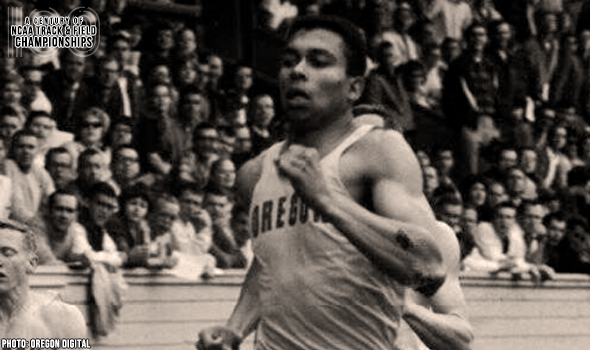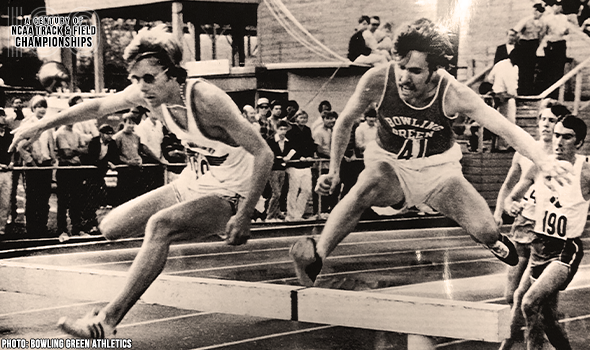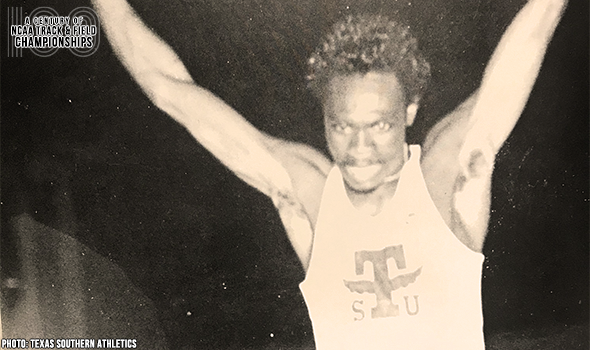
Oregon’s Jerome Sprinted To NCAA Glory
If ever a meet could have used photo-finish timing, it was the 1964 NCAA Outdoor Track & Field Championships.
The 5000 and 400 were both ruled deadlocks, but those were with merely two runners inseparable.
The 100-meter final saw three sprinters crossing the line at almost the same instant: Harry Jerome of Oregon, Edwin Roberts of North Carolina Central and Trenton Jackson of Illinois.
It took almost an hour to sort the finish, but when they did, Jerome was ruled the victor in 10.1. Roberts (second) and Jackson (third) were also credited with that same mark as well.
“Honestly, that’s one I’d hate to judge on,” Jerome said about the finish to Dick Leutzinger of the Eugene Register-Guard. “Usually I know when I win or lose. I’d hate to say on that one.”
While the 10.1 was a meet and collegiate record, it wasn’t a PR for Jerome. He still owned a share of the world record of 10.0 that he set in the summer after his freshman season back in 1960.
Jerome was a Canadian prodigy who came from great lineage. As a high school standout in North Vancouver, British Columbia, he broke a 31-year-old national record in the 220 yards. And many knew his grandfather, John Armstrong Howard, who was the first Black athlete to represent Canada in the Olympic Games.
The fact that Jerome was even running in 1964 – near his best, let alone at all – was a comeback story for the ages. Jerome tore his quadriceps tendon in the fall of 1962 at the British Commonwealth Games and the seriousness of the injury led many to believe that he would never run again. He didn’t believe that and a little over a year later, he opened the 1964 season by equaling the world indoor best in the 60-yard dash with his time of 6.0.
Then at the 1964 NCAA Championships, Jerome doubled back in the 200, taking third to lead Oregon to its second team title in three years – both at Hayward Field. The Ducks won their first national title in 1962 when Jerome won the 220 yards and was runner-up in the 100.
Not long after that, Jerome went to the Tokyo Olympic Games, where he earned his lone Olympic medal – a bronze in the 100.
Jerome died in 1982 of a brain aneurysm at age 42. In 1984, the Labatts Classic held in Burnaby was renamed the Harry Jerome Classic and in 1988 a statue of him was erected in Vancouver’s Stanley Park.
The NCAA and collegiate track & field will mark a momentous milestone in the spring of 2021 -- the 100th anniversary of the NCAA Championships and with that, the NCAA Track & Field Championships. In June 1921, the University of Chicago hosted the first track & field championships in NCAA history.
This point can’t be emphasized enough: Not only was the event the first for NCAA track & field, but the first championships for any sport under the sponsorship of the NCAA.
To celebrate, over each of the next 365 days, the U.S. Track & Field and Cross Country Coaches Association (USTFCCCA) will celebrate moments, student-athletes, and coaches that have made a century’s worth of championships special. From humble beginnings to important historical milestones to the modern-day, collegiate track & field has evolved with the American society.
The 2021 edition of the NCAA Division I Outdoor Track & Field Championships begin with preliminary round action on May 27-29 in Jacksonville, Fla., and College Station, Texas. The championships final site and culmination of the celebration is slated for June 9-12, 2021 at the newly rebuilt Hayward Field in Eugene, Ore.

Bagyula Boasted Incredible Pole Vault Prowess
Istvan Bagyula won three consecutive pole vault titles at the NCAA DI Outdoor T&F Championships between 1990 & 1992. He was the first to clear 19 feet (5.80m) in 1991.

Rotich Went Back-To-Back-To-Back In Steeple
Anthony Rotich won three consecutive steeplechase titles, doing so from 2013 to 2015. His 8:21.19 from 2013 is the ninth fastest mark in meet history.

Lawrence Twins Doubled Down On Outdoor Crowns
Twins Shadae & Shardia Lawrence both won titles at the NCAA Division I Outdoor T&F Championships: Shardae in the discus (2017); Shardia in the triple jump (2019).

Sink Steepled Into The Record Book
Sid Sink won back-to-back titles in the steeplechase at the NCAA Division I Outdoor T&F Championships in 1970 & 1971. He set meet records in each of those years.

Georgia Tech’s Taylor Triumphed In 1998
Angelo Taylor won the 400 Hurdles and doubled back to anchor the winning 4×400 relay team at the 1998 NCAA DI Outdoor Track & Field Championships.

Tennessee’s Skinner Set Javelin MR In 1970
Bill Skinner set a meet record in the javelin of 82.49m (270-8) at the 1970 NCAA Division I Outdoor T&F Championships.

Turner Left No Doubt In 800 Meters
Inez Turner won the 800 meters at the 1995 NCAA Division I Outdoor T&F Championships by 2.24 seconds for what is still the largest margin of victory in meet history.

Cheruiyot Won By Slim Margin In 1989
Kip Cheruiyot beat teammate Peter Rono by 0.03 seconds in the 1500 at the 1989 NCAA DI Outdoor T&F Championships. It was the closest margin of victory since the NCAA adopted FAT.

Emordi Led Texas Southern 1-2 LJ Finish In 1987
Paul Emordi led the only 1-2 finish by teammates in the men’s long jump at the NCAA Division I Outdoor Track & Field Championships in 1987. Emordi won with a leap of 8.25m (27-0¾).

Anchor Down: Tolbert Set 400H CR In 1997
Ryan Tolbert set a collegiate record in the 400 Hurdles of 54.54 at the 1997 NCAA Division I Outdoor T&F Championships. Tolbert also finished third in the open 400!

